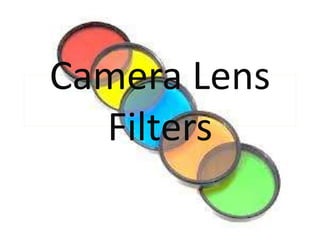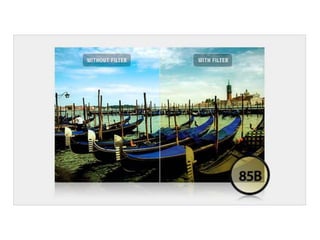Camera Lens Filters
- 2. âĒ can enhance colors, add special effects and reduce reflections âĒ can protect lenses for capturing scenery in extremely difficult lighting conditions âĒ are often necessary to modify the light before it enters the lens âĒ at the same time, lens filters can actually hurt photographs if they are not properly used Lens Filters
- 3. Notes on Choosing a Filter for a Camera Lens Lens filters generally come in two varieties: 1. Front filters â more flexible = can be used on virtually any lens diameter; may also be more inefficient to use since they may need to be held in front of the lens. On the other hand, filter holder kits are available that can improve this process.
- 4. Front Filter Holder Ring
- 5. Notes on Choosing a Filter for a Camera Lens Lens filters generally come in two varieties: 2. Screw-on filters â can provide an air- tight seal when needed for protection, and cannot accidentally move relative to the lens during composure. Disadvantage: a given screw-on filter will only work with a specific lens size.
- 7. Notes on Choosing a Filter Size for a Camera Lens Screw-on filter - expressed in terms of its diameter, which corresponds to the diameter usually listed on the top or front of your camera lens - listed in millimeters and usually ranges from about 46 to 82 mm for digital SLR cameras
- 9. Notes on Choosing a Filter Height for a Camera Lens âĒ the height of the filter edges may also be important âĒ ultra-thin and other special filters are designed so that they can be used on wide angle lenses without vignetting (the reduction of an image's brightness or saturation at the edges compared to the image center) âĒ but may also be much more expensive
- 10. vignetting
- 11. vignetting
- 12. vignetting
- 13. Types 1. Circular screw-on filters âĒ most common âĒ mounts directly on the lens filter thread âĒ e.g. UV/Clear/Haze filters, circular polarizers, neutral density and color filters
- 15. Types 2. Square filters âĒ a popular choice for landscape and other photography âĒ a filter holder directly attaches to the lens filter thread and can hold one or more filters âĒ the most popular sizes are 3Ã3 and 4Ã4 âĒ can be stacked together in certain situations, which can negatively impact image quality and add reflections.
- 16. square filters
- 17. Types 3. Rectangular filters âĒ another popular choice, primarily among landscape photographers âĒ mounted just like square filters via a filter holder system âĒ unlike square filters, they have more room to move up and down âĒ the most popular size is 4Ã6, although larger and smaller filter sizes are also available
- 19. Types 4. Drop-in filters âĒ these filters are used inside long telephoto lenses, due to the large size of the front lens element âĒ only clear and polarizing filters are used for drop-in filters
- 20. drop-in filters
- 21. Filter Factor âĒ filters change the dynamics of the light entering the lens and usually require you to alter your exposure to compensate for this fact which is called Filter Factor âĒ each filter has a specific filter factor
- 22. Filter Factor 1. UV filter âĒ transparent filters that block ultra-violet light to reduce the haziness that is noticeably apparent in some daylight photography âĒ doesnât affect the majority of visible light, so itâs a perfect form of lens protection and it will not alter your exposure
- 24. Filter Factor 2. Polarizing filter âĒ can be used to darken overly light skies as it increases the contrast between clouds and the sky âĒ like the UV filter, the Polarizer reduces atmospheric haze, but also reduces reflected sunlight âĒ most typical function: to remove reflections from water and glass âĒ two types: linear and circular
- 26. Filter Factor 3. Color Balancing filter âĒ use this to affect a change in your light sources and to compensate for the various differences in the photographed color of light
- 27. Filter Factor 3. Color Balancing filter âĒ 85B (warm-up/orange filter) enables you to shoot in the daylight when the white balance/color temperature is set for tungsten. Without the 85B filter, your image will have a blue color cast to it
- 30. Filter Factor 3. Color Balancing filter âĒ 80A (cool-down/blue filter) enables you to shoot under tungsten light when the color temperature/white balance is set for daylight. Without the 80A, your image will be abnormally warm/reddish orange
- 32. Filter Factor 4. Neutral Density filter âĒ reduces the amount of light entering the lens âĒ is helpful when the contrast between the highlights and shadows is too great to get a quality exposure âĒ can enable greater motion blurring and image detail by allowing a large aperture and/or a slow shutter speed to be used
- 34. Filter Factor 5. Soft Focus filter âĒ reduces the sharpness of an image, but only to an extent that is barely noticeable âĒ useful in shooting close up shots of peopleâs faces âĒ with the help of a little diffusion; imperfect skin conditions are replaced by silky smooth skin âĒ you can use soft focus filters while photographing landscapes or monuments as well
- 36. Filter Factor 6. Filters for B&W Photography âĒ there are specific filters for B&W photography that lighten similar colors and darken opposite colors, thereby enhancing the monochromatic look
- 37. Filter Factor 5. Filters for B&W Photography Red filters âĒ are a favorite among landscape photographers and are often used to add drama âĒ in nature photography, this will increase the contrast between red flowers and green foliage âĒ will deepen a blue sky and make white clouds pop out âĒ can also decrease the effects of haze and fog âĒ in some cases, depending on its strength, a red filter could even turn the sky black
- 39. red filter
- 40. Filter Factor 5. Filters for B&W Photography Orange filters âĒ increase contrast between tones in textures such as tile or bricks, making it a good choice for general use and urban or abstract photography âĒ it also helps to decrease haze and fog, but itâs effects on the sky and clouds are subtler than the red filter
- 41. orange filter
- 42. Filter Factor 5. Filters for B&W Photography Yellow filters âĒ subtler than orange filters, making it a âclassicâ choice for beginners just starting to explore using filters with black and white photography âĒ helps to darken the clouds slightly, and it also separates light green foliage from the darker shades of green
- 43. yellow filter
- 44. Filter Factor 5. Filters for B&W Photography Green filters âĒ lighten dark green foliage and boost light green foliage âĒ have a more specific use and are not as commonly used as the other filters, but these are extremely useful for nature photographers âĒ may lighten the sky, so landscape photographers should take note of this when using it
- 45. green filter
- 46. Filter Factor 5. Filters for B&W Photography Blue filters âĒ not as commonly used in black and white photography because they lighten the sky and darken highlights or colors that are seen as light âĒ can draw attention to haze and fog, which can enhance the mood of the photo if needed
- 47. blue filter
- 48. Conclusion Photographic filters âĒ are used to achieve image enhancement effects that can change the tone and mood of your photographs âĒ inject slight, but noticeable alterations to your image âĒ unlike editing softwares, you can immediately see the difference to your image in the viewfinder when you use a filter âĒ the effects of filters are more pronounced when working in B&W, as the monochromatic tonal scale reacts much differently, and also with greater dramatic affect
- 49. References: âĒ Lens Filters | Camera Lens Filters Explained. Retrieved from http://www.exposureguide.com/lens-filters.htm âĒ Choosing a Camera Lens Filter. Retrieved from http://www.cambridgeincolour.com/tutorials/camera-lens-filters.htm âĒ Lens Filters Explained. (2011, September 8). Retrieved from https://photographylife.com/lens-filters-explained

















































